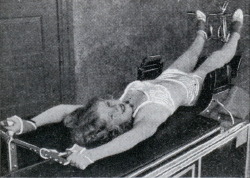Medicine
A Miracle or a Freak of Nature?

Posted By: Nethie - Fri Jun 26, 2009 -
Comments (5)
Category: Family, Health, Medicine, Science
One Step Closer To The Matrix

Posted By: Nethie - Thu Jun 04, 2009 -
Comments (1)
Category: Medicine, Science, Technology, More Things To Worry About, Brain
Medical Weirdness
In a "stimulus package" of their own devising, Pharmaceutical giant Pfizer have announced they are going to provide 70 drugs, including Viagra, free to America's recently dis-employed. Sadly, what might have been cure for those recession blues is limited to people who had already been prescribed one of the drugs prior to being laid off (New Scientist).And ladies, with all that free Viagra about to hit the streets, now would be a good time to look your best. So what better way to rejuvenate your skin and cast off unsightly wrinkles than though injections of a compound derived from babies' foreskins. In what is, amazingly, not a joke, a British company has developed, and received UK approval for, a treatment called "Vavelta" that contains live fibroblasts harvested from the bits of baby boys left over after a circumcision. Each vial of the drug is only enough to revive less than a square inch of skin, and costs $1000. But you'll have to travel to get it, the FDA have yet to approve its use in the US (Scientific American).
Of course, it's not just your looks that needs tending as you get older, your mind needs attention too. Fortunately researchers have just announced that increased vitamin D is just the thing to keep us thinking flawlessly. Vitamin D, you will remember, comes to us mainly through eating oily fish and from exposure to the sun. So start saving for that Miami condo now (Telegraph).
Meanwhile, in a case of medical irony, one little spoken of casualty of the strategic arms treaties and test bans has been the availability of medicinal isotopes such as those used in radiography and some cancer treatments. Today, all isotopes for the Americas are supplied by just one facility, the MAPLE facility in Ontario, also the world's oldest operating nuclear reactor. Only now, it's shutting down over safety concerns, and there's no replacement ready (National Post).
Finally, as an irony supplement, researchers have discovered that Down syndrome, a genetic condition that causes a host of physical and mental problems, also protects against some forms of cancer. Down syndrome is caused by having an extra copy of one chromosome, and it is through having an additional copy of one of the genes on that chromosome, which interferes with the formation of blood vessels, that sufferers from DS are less susceptible to many 'solid tumor' cancers. It's hoped that this discovery might lead to better ways to fight cancer in the future (Science).
Posted By: Dumbfounded - Thu May 21, 2009 -
Comments (5)
Category: Babies, Health, Medicine, Brain
Kook Dentist Martin Van Butchell
Martin Van Butchell was one of the most popular dentists in eighteenth-centuryBesides pulling teeth, he also specialized in the treatment of ruptures and anal fistulas. But here's the best part: "When his first wife, Mary died, Martin arranged for her body to be embalmed and publicly displayed in his dental office for advertising purposes."
There's more about Van Butchell in Wikipedia.
Posted By: Alex - Thu Apr 23, 2009 -
Comments (11)
Category: Death, Medicine
Girl Weeps Crystals
Girl Has Crystals Coming Out Of Eyes - The best free videos are right here
Posted By: Paul - Mon Apr 13, 2009 -
Comments (4)
Category: Frauds, Cons and Scams, Human Marvels, Medicine, Middle East
The Man Who Swallowed Clasp-Knives
An account of the life and death of John Cummings, a man who strove to earn a Darwin Award long before the concept of Darwin Awards existed. Reported in the Chicago Tribune, March 14, 1880:He paid dearly for his frolic; for he was seized with constant vomiting, and pain in the stomach. Taken to a hospital, he was by efficacious medical treatment relieved, as he imagined, of all the knives he had swallowed. But in this he would appear to have been mistaken. Portions of knives undissolved remained in his stomach. The amount of relief, whatever it was, did not cure the poor wretch of his folly. When at Spithead in December, 1805, and somewhat tipsy, he resumed his boastfulness of being able to swallow knives, and to amuse the ship's company swallowed nine clasp-knives, some of them of a large size. Again he became ill, and was in the hands of the ship's surgeon for several months, during which portions of knives were discharged. At length he was admitted as a patient at Guy's Hospital in 1807, and again he came to the hospital in 1808. There he remained, sinking under his sufferings, until March, 1809, when he died in a state of extreme emaciation.
Posted By: Alex - Sun Apr 12, 2009 -
Comments (5)
Category: Death, Medicine, Performance Art
The Woman Who Swallowed a Fork
 All the blogs have been posting the x-rays of the Chinese man who swallowed a pair of scissors. He was using them to clean his teeth. But here at Weird Universe we don't like doing what everyone else is doing. So instead, I present you with a similar case, from 1919, of an Irish woman who swallowed a fork, reported in the Proceedings of the Royal Society of Medicine:
All the blogs have been posting the x-rays of the Chinese man who swallowed a pair of scissors. He was using them to clean his teeth. But here at Weird Universe we don't like doing what everyone else is doing. So instead, I present you with a similar case, from 1919, of an Irish woman who swallowed a fork, reported in the Proceedings of the Royal Society of Medicine:Unfortunately, the X-ray department was not working on that day, and it was two days before a plate could be got to prove that she had swallowed a fork. The plate shows the fork in the stomach, with the handle resting near the pylorus, and the prongs towards the cardia. I operated upon her fifty-four hours after she swallowed the fork, making a small incisiion in the epigastric region to the right of the mid-line, and making a ¾ in. incision in the anterior wall of the stomach, near the pylorus, I seized the prongs of the fork and extracted it. The stomach had made an attempt to pass it on: the handle was in the duodenum, and the hilt of the fork in the pylorus, the prongs in the stomach. Suture was done in the ordinary way, and she made a very successful recovery, going out in a fortnight. Later she said she felt no ill-effects and had no indigestion.
Posted By: Alex - Sat Apr 04, 2009 -
Comments (7)
Category: Medicine, Surgery
Machine to Cure Headaches
 Image from modernmechanix.com. Text from the Salt Lake Tribune, Dec 10, 1939:
Image from modernmechanix.com. Text from the Salt Lake Tribune, Dec 10, 1939:Sufferers from chronic headaches may be interested in the contrivance pictured herewith. The inventor calls it a mechanical chiropractor and he says that through its use it is possible to find relief from headaches, poor circulation and indigestion.
The machine is somewhat complicated but it is said to put a patient through a course of exercises as vigorous as those employed by a skilled chiropractor. It is said to also correct curvature of the spine, weakness and many other ailments in the treatment of which the average chiropractor specializes.
Posted By: Alex - Mon Feb 23, 2009 -
Comments (8)
Category: Inventions, Medicine
The Amazing Dr. Clitterhouse
Besides having a great porn-movie title, this film starring Edward G. Robinson is just all over the map. Part comedy, part high-society drama, part courtroom drama, part gangster film, it features the loony premise of a medical doctor who becomes a crook for research purposes. Toss in Claire Trevor's weird lisp, and it's a surefire WU candidate!
Posted By: Paul - Sat Feb 14, 2009 -
Comments (9)
Category: Medicine, Movies, Stupid Criminals, 1930s
Shoe-Smell and Epilepsy
An article in Clinical Neurology and Neurosurgery examines whether "shoe-smell" is an effective treatment for epilepsy. The authors note:I wondered what kind of shoe-smell they were talking about. Apparently it's stinky shoe smell. The stinkier the better. The authors were skeptical that shoe-smell could work, but they end up concluding that it probably did help:
Posted By: Alex - Sat Jan 31, 2009 -
Comments (4)
Category: Medicine

| Who We Are |
|---|
| Alex Boese Alex is the creator and curator of the Museum of Hoaxes. He's also the author of various weird, non-fiction, science-themed books such as Elephants on Acid and Psychedelic Apes. Paul Di Filippo Paul has been paid to put weird ideas into fictional form for over thirty years, in his career as a noted science fiction writer. He has recently begun blogging on many curious topics with three fellow writers at The Inferior 4+1. Contact Us |




